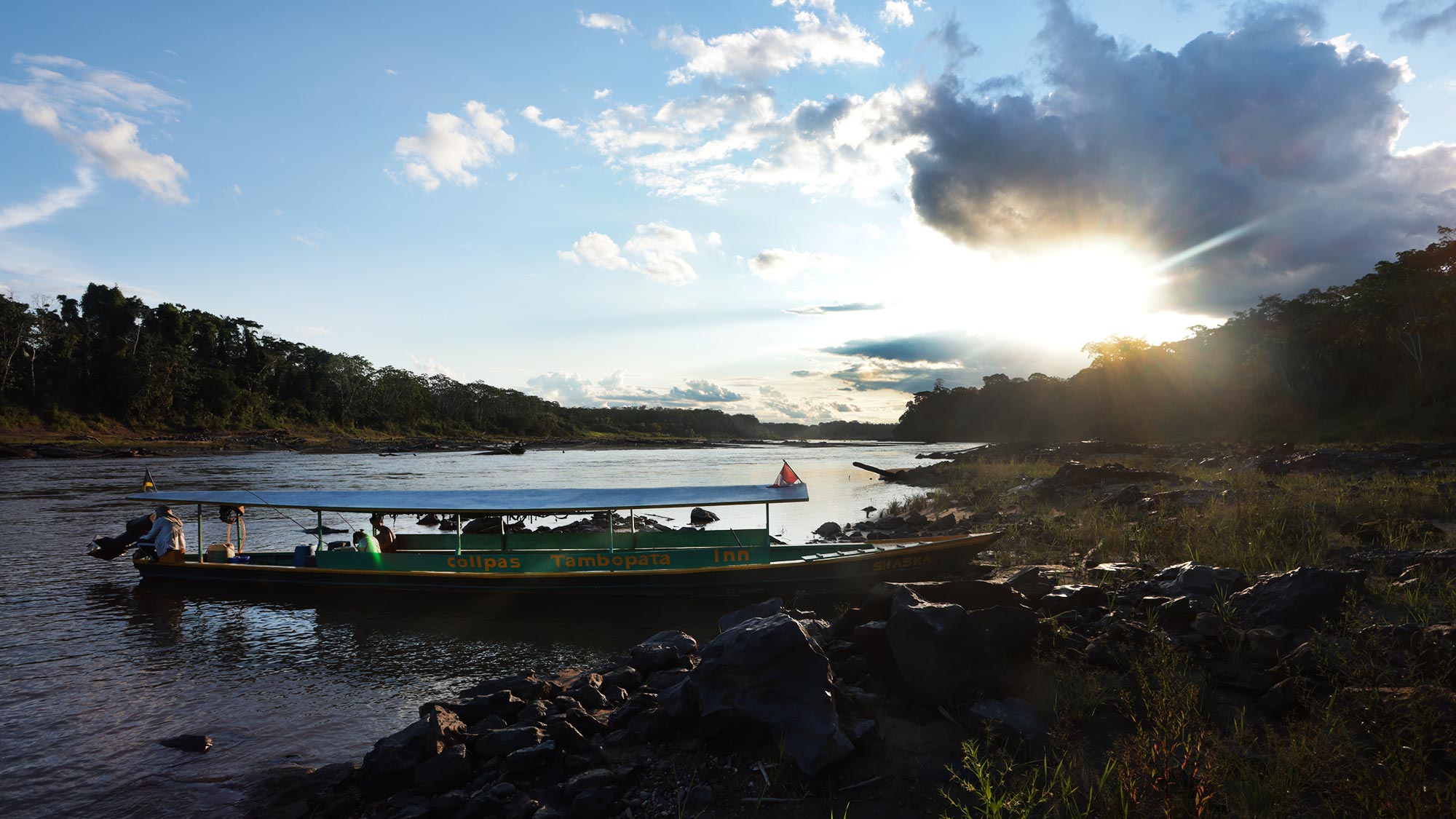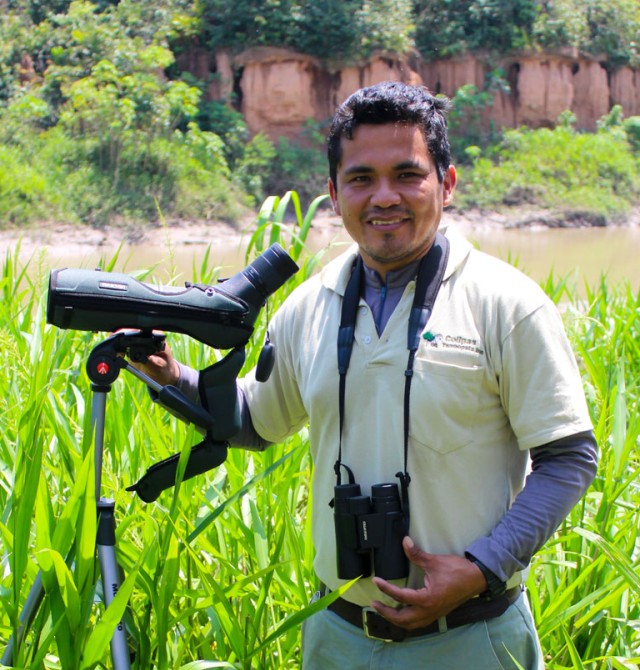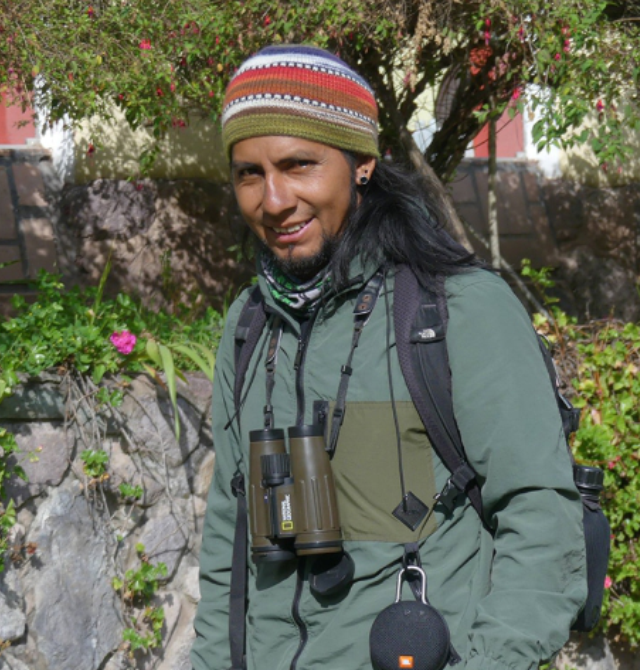
ABOUT TAMBOPATA, PERU
Tambopata is a river, a national reserve and a province in Madre de Dios state, southeastern Peru. It harbors some of the most biodiverse rainforest in the country (and possibly the entire Amazon basin), huge protected areas, and is home to several thousand people. Remote, wild, but still easily accessible, this contrasting combination has helped it to become one of the global hotspots for ecotourism.
You get a hint of why Tambopata is such a wild area just before you land at the Puerto Maldonado airport. At the end of a quick flight to Tambopata from Lima or Cuzco, a sprawling carpet of jade green comes into view and stretches to the horizon. There are a few farms, a couple of roads, and the city of Puerto Maldonado is visible but these are still dwarfed by the sea of Amazon rainforest that marches into the distance. Meandering, coffee-colored rivers weave their way through the green. Massive, old growth Ceibas and other rainforest giants emerge from a 90 foot high canopy. Hidden beneath the trees are troops of monkeys, toucans, brilliantly colored macaws, and even jaguars. You never know what you are going to encounter in the rainforests of Tambopata but that view from the plane promises adventure and a once in a lifetime experience.
A Brief History of Tambopata
“Tambopata” is derived from two Quechua words that mean “inn” or “place of accommodation” (tambo) and “high point” (pata). The reason why the rather flat, lowland rainforests received this name is not forthcoming but may reflect Andean foothill areas of Tambopata that were visited by Incan peoples. Despite its Quechua name, the region wasn’t really used by the Incans for much of their history. was first settled thousands of years ago by indigenous, Amazonian ethnies such as the Ese’Eja. Living in small villages, they cultivated yuca and hunted in the surrounding forests. The plants of the rainforests also provided them with building materials and a wide variety of medicine.
During the Spanish colonial period, access to the Tambopata region was so difficult that it was largely ignored and left to its own devices. This changed at the beginning of the twentieth century during the Peruvian rubber boom. As people from outside the region searched Tambopata and many other areas in southeastern Peru for rubber trees, they frequently came into conflict with indigenous groups. Many locals were enslaved and perished from diseases brought by the new colonists. Although the rubber boom didn’t last that long, it made a big impact on indigenous groups of the Tambopata region and their populations declined as a result.
Tambopata, Peru in modern times
Decades later, colonists to Tambopata began to arrive from the highlands in search of a better life and gold that had been found in the rivers. Shortly thereafter, the first eco-lodge was built in the area and tourists slowly began to make their way to Tambopata. As word spread about the amazing diversity of the Tambopata region, it grew in popularity as a destination and became one of the most popular sites to visit in Peru after the year 2000.
Tambopata continues to be a destination of choice for thousands of people experiencing Peru. Increasing numbers of colonists and pressure on the rainforests from mining and a new road linking the Pacific and Atlantic Oceans have been challenges to conservation, but large protected areas and the importance of ecotourism help to buffer these threats.
The Tambopata National Reserve
The first protected area in Tambopata was the Tambopata Reserved Zone. Established in 1977, it encompassed over 5,000 hectares of lowland rainforest and palm swamps near Explorer’s Inn. In 1990, this protected zone was expanded to include the watersheds of the Tambopata and Candamo Rivers and thus grew in size to a massive 271,000 hectares. Shortly thereafter, the name of this protected area was also changed to the Tambopata National Reserve. Combined with the adjacent Bahuaja Sonene National Park and the Madidi National Park in Bolivia, these sister reserves protect a scarcely inhabited tropical rain forest the size of Belgium (over 3,000,000 hectares or 30,000 square kilometers)
Tambopata rainforests= biodiversity hotspot
Situated on the southern side of the Tambopata River, this huge area of beautiful lowland rainforests harbors an equally impressive array of biodiversity. The numbers of species that make their homes in these rainforests demonstrates why the region is often referred to as the most biodiverse place on Earth. It harbors:
serve to the south. This is also where the Research Center is located.
Guests of the Rainforest Expeditions lodges get the chance to experience this biodiversity because lodges such as Refugio Amazonas and Posada Amazonas are located adjacent to the National Reserve. The wild nature of the National Reserve is further protected by the presence of the one million hectare Bahuaja Sonene National Park that abuts the reserve to the south. This is also where the Research Center is located.
Wildlife in the National Reserve
The combination of these huge protected areas makes it possible for Rainforest Expeditions guests to encounter fantastic wildlife, such as:
meet our team
GERSON MEDINA

CEO & Founder
Gerson was born and raised on Tambopata River near Puerto Maldonado. After studying ecotourism, and working for Rainforest Expeditions for six years as a bird watching specialist and adventure guide, he decided to organize his own tours and expeditions for backpackers and budget travelers
JESUS CIEZA

Guide
Bird and Nature Tour Guide who has been working as a freelance for some Bird Companies and now decided to operate his own he was part of the team who run the first Birding Rally Challenge done in southeastern Peru in 2012

